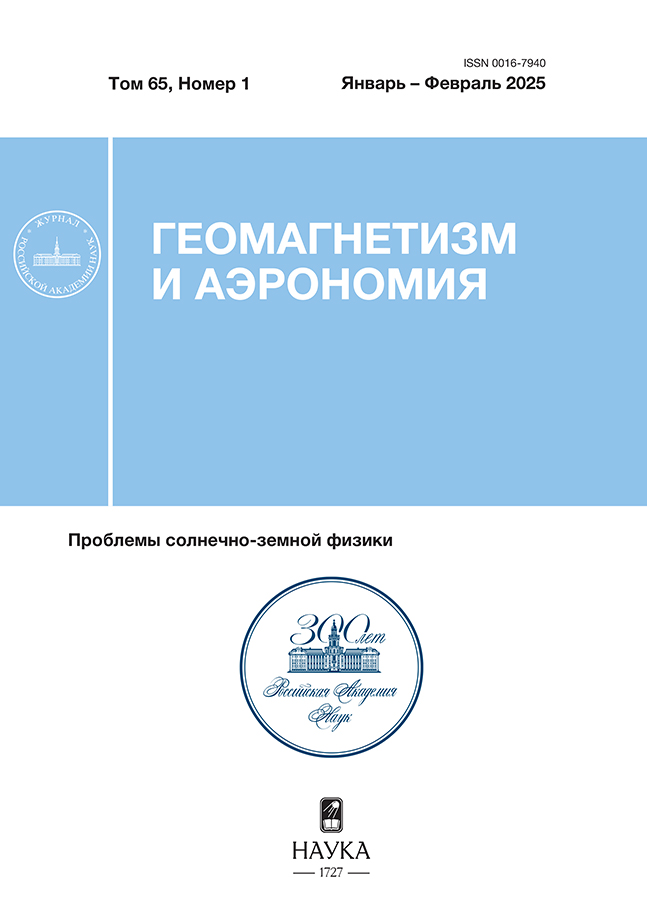Application of artificial neural networks for reconstruction of vector magnetic field from single-component data
- Авторлар: Rytov R.A.1, Petrov V.G.1
-
Мекемелер:
- Pushkov Institute of Terrestrial Magnetism, Ionosphere and Radio Wave Propagation, Russian Academy of Sciences, IZMIRAN
- Шығарылым: Том 65, № 1 (2025)
- Беттер: 118-126
- Бөлім: Articles
- URL: https://rjmseer.com/0016-7940/article/view/684622
- DOI: https://doi.org/10.31857/S0016794025010109
- EDN: https://elibrary.ru/ADKBHQ
- ID: 684622
Дәйексөз келтіру
Аннотация
In this work the problem of reconstructing the vector anomalous magnetic field from single-component data was solved by means of artificial neural networks. For training an artificial neural network a database of anomalous magnetic field components Bx, By, Bz was created using a set of point magnetic dipoles lying under the field measurement plane. Using a synthetic example, the work of a trained neural network was shown in comparison with a well-known numerical algorithm for restoring a vector field from data of one component. Further, according to the data of the vertical component of the anomalous geomagnetic field the horizontal components of the anomalous geomagnetic field were restored using artificial neural networks in the territory of 58 – 85° E, 52 – 74° N with a grid step of 2 arc minutes.
Толық мәтін
Авторлар туралы
R. Rytov
Pushkov Institute of Terrestrial Magnetism, Ionosphere and Radio Wave Propagation, Russian Academy of Sciences, IZMIRAN
Хат алмасуға жауапты Автор.
Email: ruslan.rytov2017@ya.ru
Ресей, 142190, Troitsk, Moscow
V. Petrov
Pushkov Institute of Terrestrial Magnetism, Ionosphere and Radio Wave Propagation, Russian Academy of Sciences, IZMIRAN
Email: vgpetrov2018@mail.ru
Ресей, 142190, Troitsk, Moscow
Әдебиет тізімі
- Колесова В.И. Аналитические методы магнитной картографии. Москва: Наука, 1985.
- Колесова В.И., Черкаева Е.А. Вычисление компонент векторного аномального геомагнитного поля по модульным данным. Препринт № 46 (735). М.: ИЗМИРАН, 1987.
- Яновский Б.М. Земной магнетизм. Ленинград : Изд-во ЛГУ, 591 c. 1978.
- Abadi M. et al. Tensorflow: Large-scale machine learning on heterogeneous distributed systems //arXiv preprint arXiv:1603.04467. https://doi.org/10.48550/arXiv.1603.04467. 2016.
- Alken P., Thébault E., Beggan C.D., et al. International Geomagnetic Reference Field: the thirteenth generation // Earth, Planets and Space. V. 73. № 1. P. 1–25. https://doi.org/10.1186/s40623-020-01288-x. 2021.
- Barkhatov N.A., Vorobjev V.G., Revunov S.E., et al. Effect of solar dynamics parameters on the formation of substorm activity // Geomagn. Aeron. V. 57. P. 251–256. https://doi.org/10.1134/S0016793217030021. 2017.
- Buchanan A., Finn C.A., Love J.J., et al. Geomagnetic referencing—the real-time compass for directional drillers // Oilfield Review. V. 25. № 3. P. 32−47. 2013.
- Coskun U.H., Sel B., Plaster B. Magnetic field mapping of inaccessible regions using physics-informed neural networks //Scientific Reports. V. 12. № 1. P. 12858–12867. https://doi.org/10.1038/s41598-022-15777-4. 2022.
- Kaftan İ. Interpretation of magnetic anomalies using a genetic algorithm // Acta Geophysica. V. 65. № 4. P. 627–634. https://doi.org/10.1007/s11600-017-0060-7. 2017.
- Kaji C.V., Hoover RC., Ragi S. Underwater Navigation using Geomagnetic Field Variations / 2019 IEEE Intern. Conference on Electro Information Technology (EIT). https://doi.org/10.1109/eit.2019.8834192. 2019.
- Kingma D.P., Ba J. Adam: A method for stochastic optimization //arXiv preprint arXiv:1412.6980. 2014.
- Krizhevsky A., Sutskever I., Hinton G.E. Imagenet classification with deep convolutional neural networks //Advances in neural information processing systems. V. 25. P. 1097–1105. 2012.
- Lourenco J.S., Morrison H.F. Vector magnetic anomalies derived from measurements of a single component of the field // Geophysics. V. 38, № 2. P. 359–368. doi: 10.1190/1.1440346. 1973.
- Maus S. An ellipsoidal harmonic representation of Earth’s lithospheric magnetic field to degree and order 720, Geochem. Geophys. Geosyst., 11, Q06015, https://doi.org/10.1029/2010GC003026. 2010.
- Montesinos F.G., Blanco-Montenegro I., Arnoso J. Three-dimensional inverse modelling of magnetic anomaly sources based on a genetic algorithm // Physics of the Earth and Planetary Interiors. V. 253. P. 74–87. https://doi.org/10.1016/j.pepi.2016.02.004. 2016.
- Pollok S., Bjørk R., Jørgensen P.S. Inverse design of magnetic fields using deep learning //IEEE Transactions on Magnetics. V. 57. №. 7. P. 1‒4. https://doi.org/10.1109/TMAG.2021.3082431. 2021.
- Pollok S. et al. Magnetic field prediction using generative adversarial networks //Journal of Magnetism and Magnetic Materials. V. 571. P. 170556–170565. https://doi.org/10.1016/j.jmmm.2023.170556. 2023.
- Virtanen P. et al. SciPy 1.0: fundamental algorithms for scientific computing in Python //Nature methods. V. 17. №. 3. P. 261‒272. https://doi.org/10.1038/s41592-019-0686-2. 2020.
- Ying X. An overview of overfitting and its solutions //Journal of physics: Conference series. – IOP Publishing. V. 1168. P. 022022–022029. https://doi.org/10.1088/1742-6596/1168/2/022022. 2019.
- The National Centers for Environmental Information. (2018). [Online]. Available: https://www.ngdc.noaa.gov/geomag/geomag.shtml
Қосымша файлдар















